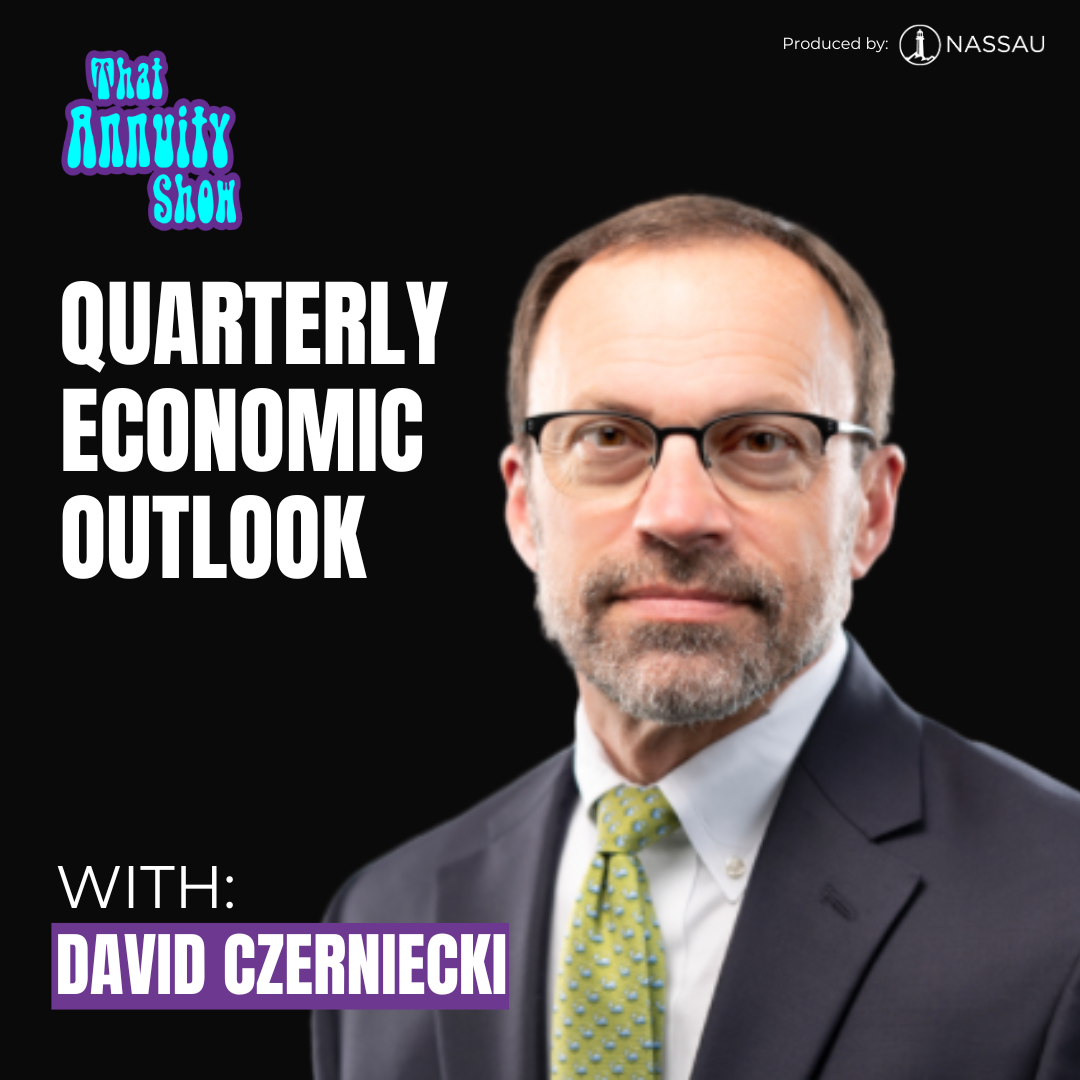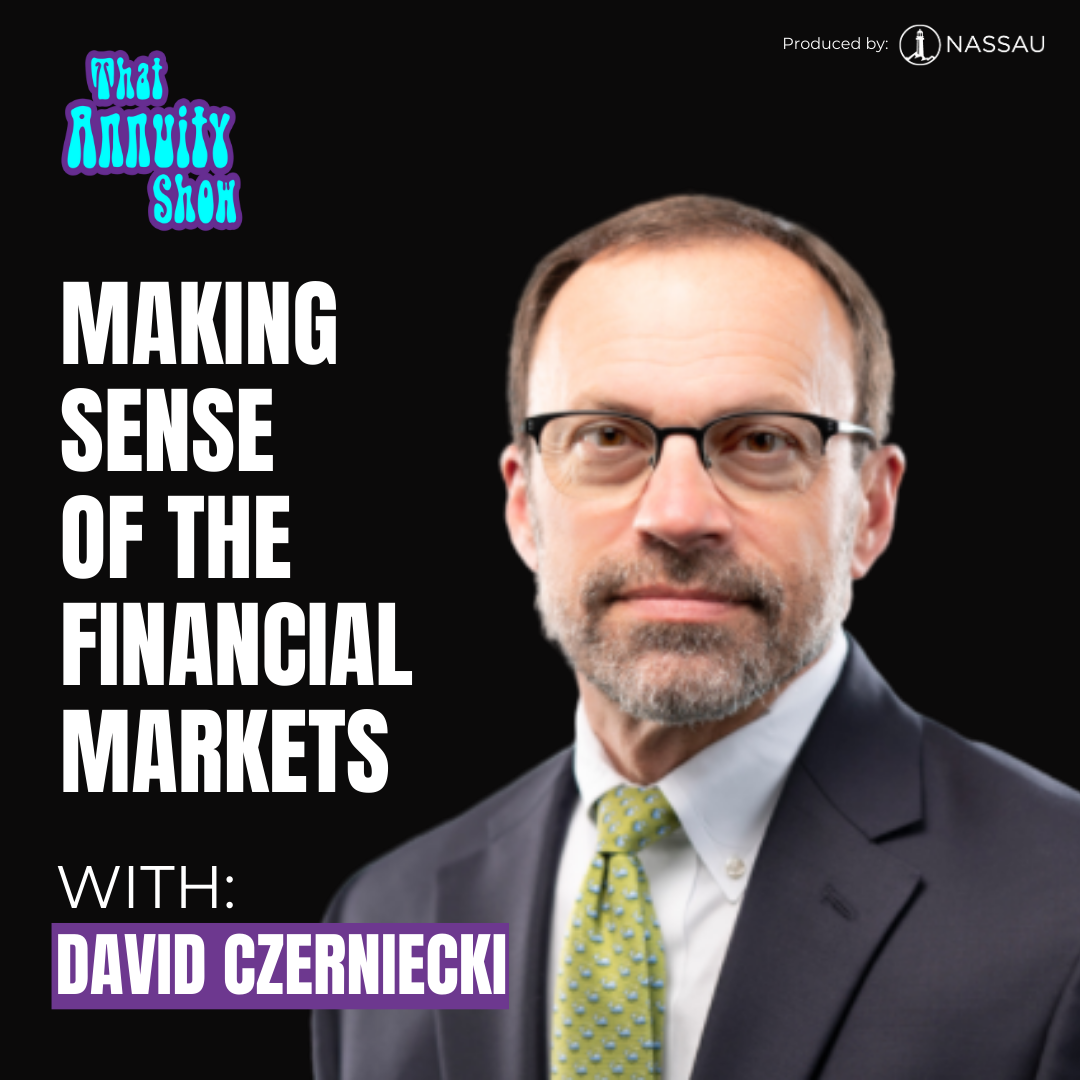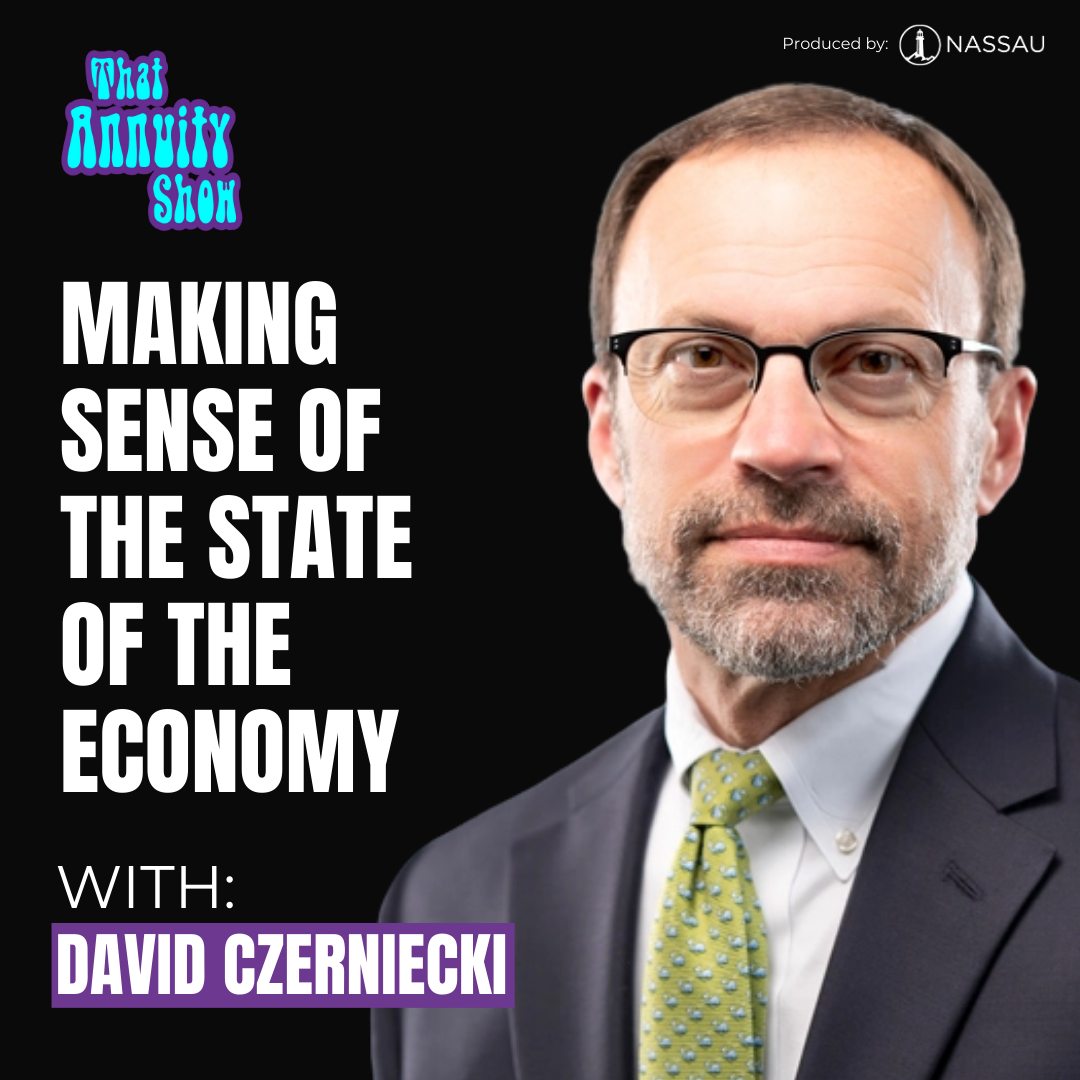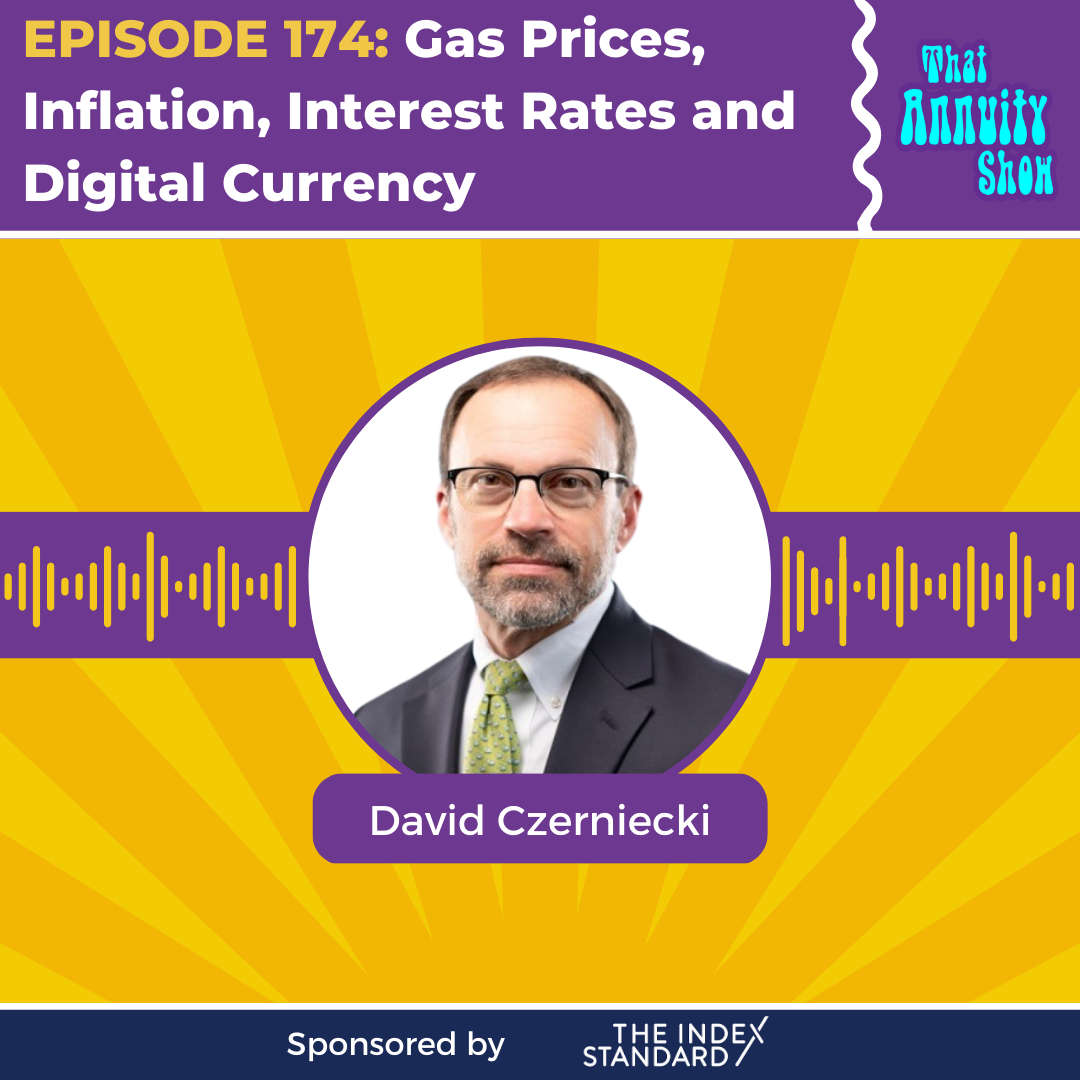Speaker 1:Today we catch up with David Zicki, chief Investment Officer for Nassau, and get his perspective on the economy. We continue our discussion from last quarter about inflation, interest rates, market volatility, and the supply chain. In addition, we discuss what we can learn from the collapse of digital currencies.
Speaker 1:We also wanna thank our primary sponsor and my employer [00:00:30] by day, NASA Financial Group. We are working harder to be your care of choice. We support you with best-in-class service. We seek to think things simple, and we will have your back in the years to come. We’re headquartered in Hartford, Connecticut with 19 billion in assets under management, and serve over 400,000 policy holders. We’ve been doing this a long time, 170 years, but we remain humble enough to always try to improve. Also, do you wanna get regular updates on news [00:01:00] about guests of our show? Go to that annuity show.com and subscribe to our newsletter. We hope you enjoy the show.
Speaker 2:Welcome to that annuity show, the podcast that will make you an expert in explaining annuities to your clients. Give us 30 minutes each week and we’ll shave hours from your client presentations. [00:01:30] Now, here’s your host, Paul Tyler.
Speaker 1:So David, welcome back and, uh, just for, for people who, who haven’t, uh, heard you before, can you tell people who are you and, uh, what do you do?
Speaker 3:Yep. Uh, Paul, good to, good to be back. Uh, thanks for having me. Um, I am the Chief Investment Officer of nasa. I manage the, I’m responsible for the management of the portfolios, for all of the insurance companies and all of our products and, and our newinand, and and [00:02:00] policy holders.
Speaker 1:Yeah. Well, thank you for joining us today. Appreciate the time and, uh, I guess we are living in some very interesting times. Uh,
Speaker 3:We are indeed
Speaker 1:<laugh>. So I’ve gotta have to follow up on some things we asked, uh, about earlier. And, uh, let, let me start with what’s probably closest to all of us, and that’s gasoline and good news. AR is, gas prices seem to have dropped. I drove up here and I saw gas prices are much lower [00:02:30] along the merit today. Now is this a, is this a good thing or is this a bad thing for the economy?
Speaker 3:Right. Um, I think we have improved in that, in that basis. You know, obviously prices at the pomp are lower. Um, it’s tough to say that we are sort of gonna stay here. Um, there are definitely economic growth implications that are playing through in gas prices. I think you’ve had a number of things play in. You’ve obviously had pretty significant releases from this, uh, strategic p petroleum reserve, [00:03:00] which has affected the market, you know, and that’s an anomaly and it can’t last. So that’s something at some point goes away. That’s thing one. I think think true. You’ve seen some changes in the way opexplaying the market a little bit right now. So that’s thing two. But I do think a factor is the anticipa an actual slowing of the economy in an anticipation of further slowdowns, um, particularly from some of your big manufacturing companies. So the, you know, obviously the war, you know, the deplorable war in, in Russia, Ukraine is still going on, so that’s still affecting [00:03:30] supplies. Um, you’re still gonna have a fairly hefty drain, um, as the colder months settlement in Europe. And, and Europe is not well positioned for this. So that’s gonna put some strain on the system. So unfortunately, I don’t think it’s all good news.
Speaker 1:Oh, no,
Speaker 3:<laugh>.
Speaker 1:Well, you mentioned jobs. Um, mm-hmm. <affirmative>, uh, layoffs in the tech sector made enormous headlines this summer. They, they, they continue to do it. Uh, there have been some layoffs, I know in some manufacturing, uh, [00:04:00] related sec, uh, companies and sectors like you’ve managed to, you’ve mentioned even here, uh, in, in the, in the, uh, new England region. Uh, but job reports are still good. Still see, see good numbers, good, good reports coming out of, uh, you know, some of the, the, uh, governmental units track this stuff. Um, are we at the tail end of something or does it mean that maybe the downturn’s not gonna be as bad, or am I just, uh, guilty of some wishful thinking here?
Speaker 3:[00:04:30] I think that it’s, it’s very early to make a call here. Uh, I certainly don’t think we’re at the height of unemployment. Um, the job market does remain fairly robust in part that’s because of, um, sort of, we still have labor shortages and, and that’s more of a, a, a demographic and long term thing. You know, we are, we’ve had less immigration for quite some time, um, and we’ve had, um, significant return to work in the 24 [00:05:00] to 54 year old age bracket. But in the 55 plus age bracket, you know, we had the great, you know, the great early retirement thing, which has been pretty sticky. So this, this, I’ll talk a little bit more about jobs, but this also gets back to the, what we talked about last time in inflation, there’s still a lot of pressure there and wage inflation goes away very slowly.
Speaker 3:The bottom line, Paul, is, is historically for the fed to sort of break the back of wage inflation, you’re probably looking at quite a bit higher level of unemployment than [00:05:30] you see today. Remember today we’re, you know, sub four in the threes. That’s probably more consistent with the five. So that’s a lot of jobs. Um, and that’s whether or not we hit that level, I don’t know, but I think we’re more likely to go in that direction than where we are. Interestingly, some of what we’ve seen thus far, and you’ve picked up on this in looking at the actual employment numbers versus the news releases, you’re seeing tech sector layoffs, but there’s a couple things that are happening. One is they’re eliminating [00:06:00] positions that didn’t, they hadn’t filled yet. They were on the drawing board, if you will. They were in the budget. So they’ve gotten rid of that. It’s not helpful from a jobs perspective, but, you know, they weren’t positioned. You’ve seen some big companies make some layoffs and you know, Amazon has announced a number of layoffs. Amazon employs a million, you know, a million and a half people, 10,000 jobs. I I, obviously, I feel badly if I’m one of those 10,000 people, but that’s not a big number, you know, relatively speaking. So, um, but you are seeing a little bit of right-sizing going [00:06:30] on there.
Speaker 1:Yeah, thanks. Now, we, we also talked about supply chain, uh, issues. Yep. Uh, you haven’t, <laugh> haven’t given, given us a, a lot of hope that this, the supply chain issues would, would go away. Uh, we saw a lot more disruption in China over the last, uh, six or seven months. And good news is it looks like China has relaxed some of their covid restrictions. Is this gonna help us with some of the supply chain issues? And if it is, how long will it take [00:07:00] for us to see this happen?
Speaker 3:Yeah. Um, I, I think the short answer is we’ve seen a significant amount of improvement here. Um, there are a number of factors that have played into it. China is a major part of that. We’ll touch on that in a second. Some of the supply issues that we faced last year were other structural bottlenecks. If you recall, the images of all the ships lined up, you know, outside the port of, um, uh, San Diego. Well, that’s, stuff is all cleared up. So the system’s working [00:07:30] betters thing one, uh, thing two is that, um, we believe that China has found ways around some of the export and tariff restrictions. So w the US is still getting a lot of goods from China. They’re just coming from someplace else. So they’re manufactured there, they go somewhere, then they get here. So they’re still, you know, so you’re still getting some supply. Uh, you are correct, and I think everyone’s optimistic that the easing of some of the, [00:08:00] uh, covid restrictions will help. But the other, you know, the, the other side of the coin is there is slowing demand. So you’re starting. So that’s part of where the balance is coming from. So we’re seeing improvement. I still think it takes a while. I don’t think new cars are gonna get a lot cheaper real soon.
Speaker 1:Yeah. Well, shifting gears a little bit to very al alternative assets. The Bahamas have been in the news lately. [00:08:30] <laugh>, uh, FTX collapsed. I’m not sure many people in mainstream market knew who FTX was. Uh, what lessons are there, if any, that we could take away from the collapse of, uh, the digital currency market?
Speaker 3:Right. Well, Paul, you know, the old saying, right, you know, history may not repeat itself, but it often rhymes. If something is too good to be true or seems too good to be true, it probably is. Um, you know, we have a situation here where it appears that [00:09:00] there’s just complete and out fraud. And, you know, part of that is, um, you have to do your homework, uh, as an investor, as an institution, I am, I have to say I’m a bit been a bit surprised at the size and scale of some of these institutions that have involved. There are certainly some big personalities that lost money in this that’s more common. Um, they’re, they’re not institutions. They don’t necessarily do the same level of diligence and, you know, big personalities who spend a lot of their time, [00:09:30] you know, being influencers. There’s a, there’s an attraction to the new shiny penny, if you will.
Speaker 3:And so this seemed exciting. So that part’s a little bit, but the fact that so many big institutions, so again, you have to do your homework. And my grandfather used to say, trust, everybody would always cut the cards, right? And I, and I think you, you have to see that, I think you’re seeing it spill over into other parts of, of the, you know, digital currency markets. Um, and I think that it, it’s gonna drive us toward a situation where you’re gonna see more, [00:10:00] um, regulation come through and come through pretty, pretty hard. And I’m, you know, you know, we as an insurance company operate in a fairly heavily regulated environment, so we’re accustomed to it, and not all regulation is bad. Uh, and particularly when you’re talking about exchange type systems, you have to have confidence in those systems. And so I think you’re gonna see more regulation there.
Speaker 1:Yeah, I’m, I’m, I’m sure we will, and we, we saw this before, um, a lot of the central [00:10:30] banks were creating structures for, for regulating the, uh, currency. It’ll be interesting to see what happens, right. Following this. Um, so I’ll put you in the hot seat interest rates. Wow. Have these interest rates driven how we, how we price our products, how we <laugh>, right? How we compete in the market. Where do you think the, what’s gonna happen with rates, do you think, over the next, uh, six months?
Speaker 3:So I think there’s two pieces to this, Paul. The, the first piece is what is the Fed doing with sort of the short term rate? I e are they still raising? And [00:11:00] I think we’re still looking at a few more raises, you know, a few more raises here. They may be smaller. Um, but I think you’re looking at a few more raises. I think in general, we’ve had a, um, we’ve had a bit of a rally in rates in the past, um, you know, few weeks here. Uh, so rates have come off quite a bit, you know, come down quite a bit. But I, I do feel that we probably give some of that back here and we stay at least at that level, if not a little bit higher. [00:11:30] Again, if you look, you know, the, the whole point of raising rates is to combat inflation.
Speaker 3:If you look at where inflation is now, um, you know, we’re still pretty high. Um, and inflation is sticky. If you look at any historical charts of inflationary trends, once it comes, it stays around for a while. The Fed is fully aware of this and, and there is no playbook where it just sort of comes right back down. And so that will require rates to stay up for a while. Again, going back to what we talked about earlier on the [00:12:00] unemployment thing. Um, you know, if, if rates were to come back down a lot, I don’t think you’d see the unemployment level get to where it effectively where the Fed would like it to be. And therefore I think you, you continue to have wage pressure and so inflation sticks around. So I think we’re, we’re in this for a bit.
Speaker 1:Yeah. You, you mentioned rally last time we talked, I think you told us that this was maybe the third time in a hundred years where equities and bonds went down, uh, bond markets recovered [00:12:30] Yep. A bit in November. Do you think this is just a short, is this a rally? Do you think we’re returning to more normal market conditions?
Speaker 3:So normal is an interesting definition here. Um, uh, I think that we have to, this is, we’ve been a, a very highly volatile time period here. And again, these are rate rises, rate increases from the Fed that are historic. We haven’t [00:13:00] seen moves like this, you know, since Volker and, and the rapid pace of driving up rates is, um, again, very much unprecedented. So from that standpoint, we’re nowhere near normal. But you have to keep in mind that we’re coming off a really, really long period of the different kind of abnormal in the low, low zero rate environment. And again, that it, it was also abnormal. So I do think it’s getting a bit more normal. I think we have [00:13:30] a period of volatility yet ahead. Um, a certain amount of volatility is normal and we were accustomed to none. So the market took this pretty hard. But I do think we have a period of, you know, volatility ahead. But I think you’re starting to see it, and it will, as we come through, that look a lot more like the rate market that, you know, over my 30 year plus years I grew up with where, you know, it did move around a bit and, and, and there was some amount of volatility. I think it’s high now. I think it was too low before. [00:14:00] So the pendulum swung from side to side and you know, we’re gonna find the middle here.
Speaker 1:All right. Well David, thanks so much for spending some time with us and, uh, we’ll look forward to, uh, catching up again in, uh, a few months. You’re
Speaker 3:Welcome, Paul. Thank you.
Speaker 2:Thanks for listening. If you’ve enjoyed the show, please rate and recommend us on iTunes, Stitcher, overcast, or wherever you get your podcast. You can also get more information@thatannuityshow.com.
 That Annuity Show
That Annuity Show















Recent Comments